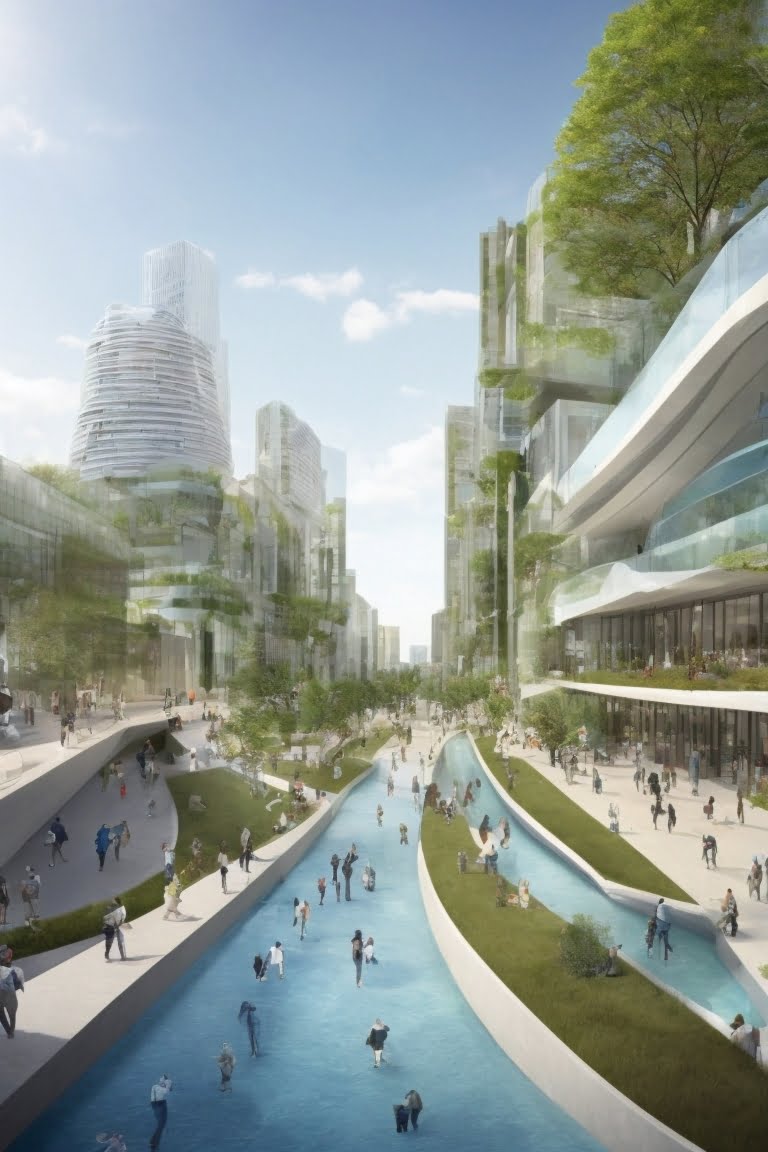Living in Lahore for the past two decades, I’ve witnessed the city’s incredible growth. New neighborhoods pop up seemingly overnight, each with its own unique character. But with this expansion comes challenges. Traffic congestion, rising energy costs, and environmental concerns are all pressing issues demanding innovative solutions.
This is where sustainable master plan architecture comes in. It’s not just about aesthetics anymore; it’s about creating developments that are not only beautiful and functional but also kind to the environment and our wallets.
Intrigued? Let’s delve deeper into this fascinating concept.
What is Sustainable Master Plan Architecture?
Sustainable master plan architecture is a holistic approach to development that considers environmental, social, and economic factors from the very beginning. Imagine it as a blueprint that outlines how a community will be built, ensuring it thrives for generations to come. This includes:
- Environmentally friendly practices: Minimizing resource consumption, utilizing renewable energy sources, and incorporating green spaces are all crucial aspects.
- Social well-being: Encouraging walkable neighborhoods, fostering a sense of community, and providing inclusive spaces are key considerations.
- Economic viability: Sustainable design often leads to long-term cost savings in terms of energy and maintenance.
Here’s a quick historical detour: While the concept of sustainable design has been around for centuries, it gained significant traction in the late 20th century. The Brundtland Commission’s 1987 report, “Our Common Future,” introduced the concept of sustainable development, which emphasizes meeting present needs without compromising the ability of future generations to meet their own. This concept heavily influenced architecture, leading to the rise of sustainable master planning.
Now, why is this so important? Because the built environment has a massive impact on our planet. Buildings are responsible for a significant portion of energy consumption and greenhouse gas emissions. Sustainable master plans offer a roadmap for responsible growth, ensuring our developments are not burdens on the environment.
The Latest Trends in Sustainable Master Plan Architecture
The field of sustainable master plan architecture is constantly evolving, with new technologies and innovative ideas emerging all the time. Here in Lahore, we’re seeing some exciting trends:
- Biophilic Design: This approach prioritizes integrating nature into the built environment. Think green roofs, vertical gardens, and parks integrated seamlessly with buildings. Studies have shown biophilic design can improve occupant well-being and even reduce energy consumption.
- Smart Technologies: From smart grids that optimize energy use to intelligent irrigation systems that conserve water, technology plays a crucial role in sustainability. Avenir Developments, for instance, has recently incorporated smart home features in their latest project, The Iris Lahore, allowing residents to monitor and control energy usage effectively.
- Focus on Resilience: Climate change is a harsh reality, and master plans are now addressing this by incorporating features that make communities more resilient to extreme weather events. This could involve flood-proofing measures, heat-resistant building materials, and designs that promote natural ventilation.
These are just a few examples, and the possibilities are truly endless. The key takeaway is that sustainable master plan architecture is not a static concept; it’s constantly evolving to meet the needs of a changing world.
Here’s a quick shoutout to our friends at the Lahore Development Authority (LDA). Their recent initiative to promote green building practices through incentives and regulations is a welcome step towards a more sustainable Lahore.
FAQs about Sustainable Master Plan Architecture
Let’s address some common questions you might have:
- Isn’t sustainable architecture more expensive? While the initial investment might be slightly higher, sustainable design often leads to significant cost savings down the line. Energy-efficient buildings and smart water management systems can translate to lower utility bills over time.
- Does sustainable design compromise aesthetics? Absolutely not! In fact, some of the most stunning and innovative architecture today embraces sustainable principles. Sustainable design can lead to visually stunning and functional spaces that are also good for the environment.
- How can I incorporate sustainable practices into my own home?
There are many ways! Start with small changes like using energy-efficient appliances, switching to LED lighting, and installing low-flow faucets. You can also explore options like rooftop solar panels or rainwater harvesting systems.
Expert Tips for Building a Sustainable Future
As a blogger who’s been following the sustainability movement for years, here are some tips I’ve learned:
- Do your research: Before buying or building, understand the sustainable features offered by different developments.
- Embrace innovation: Explore new technologies and materials that can enhance sustainability.
- Think long-term: Investing in sustainable design might cost a little more upfront, but the long-term benefits outweigh the initial cost.
- Get involved: Advocate for sustainable practices in your community. Support developers who prioritize sustainability and hold local authorities accountable for green initiatives.
- Start small, dream big: Every little bit counts! Begin with small changes in your own home and gradually incorporate more sustainable practices into your lifestyle.
Building a Greener Lahore: The Role of Avenir Developments
Here at Avenir Developments, we understand the importance of sustainable master plan architecture. We’re committed to creating communities that are not only beautiful and functional but also environmentally responsible.
Our projects incorporate the latest sustainable technologies, from energy-efficient building materials to smart home features that empower residents to manage their energy consumption. We also prioritize green spaces, fostering a connection with nature and promoting a healthy lifestyle.
We believe that sustainable development is not just a trend; it’s the future. By working together, we can build a Lahore that thrives for generations to come.
Call to Action
Ready to learn more about how Avenir Developments can help you create a sustainable future? Contact us today on WhatsApp or Call +923001101103 to discuss your architectural, interior design, and construction management needs. Together, let’s build a greener Lahore, one sustainable development at a time!







